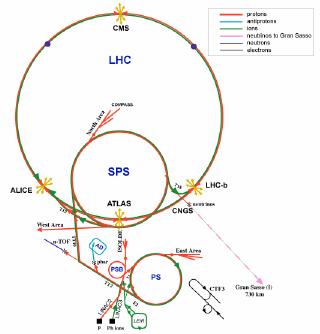Taking a closer look at LHC
Electronvolt, unit for energy denoted by eV, is used for small energies.
| 1 electron-Volt
1 eV is defined as the amount of energy equivalent to that gained by a single unbound electron (or proton) when it is accelerated through an electrostatic potential difference of one volt, in vacuo So, a 1,5 V battery provides to each electron an energy of 1.5 eV. Or the CRT of a TV set provides ~ 20 keV.
1 eV = 1.602·10-19 Joule 1 MeV = 106 eV 1 GeV = 109 eV 1 TeV = 1012 eV |
 |
|
Energies at CERN .....
(Linac2 50 MeV) Linac4 160 MeV
PSB 1.4 GeV
PS 25 GeV
SPS 450 GeV
LHC 7 TeV (maximum design value) |
 |
So, each proton reaches 7 TeV energy (maximum design value) while moving in LHC accelerator.
They would be needed 350 millions "connected" TV sets (~20 keV) to reach that energy.
Taking a 12 cm accelerator section in the CRT TV Set, we have a very special complex accelerator:
0.12 x 350·106 ~ 40·106 m (40000 km !).
"Our accelerator" should be placed on the Equator line.

So, is the CERN's accelerator complex so big?
We can also consider a common 1,5 V battery.
ELHC / EBattery = 4.7×1012.
Taking the its 5 cm size:
4.7×1012×0,05 ~ 2.3·1011 m (230 million km!).
The average distance between the Sun and the Earth is 149 million kilometers.
We can calculate the necessary orbit to cover that length:
2.3·1011 /2π
orbital radius =3.7·1010 m
So, about 100 times de Moon's orbital radius.

Definitely, LHC is not too big !!!
Mass Unit
From the equivalence between mass and energy the unit used is eV/c2 and their multiples MeV/c2 or GeV/c2 .
(1 atomic mass unit - 1 u = 0,9315 GeV/c2)
For instance:
electron mass= 0,5110 MeV/c2
proton mass= 0,9383 GeV/c2
neutron mass= 0,9396 GeV/c2
But for shortness, using the so-called "natural units" (c = 1), it is wrtitten eV ( or MeV or GeV) only, giving for sure that who reads knows how the equivalence works.
|
AUTHORS Xabier Cid Vidal, PhD in experimental Particle Physics for Santiago University (USC). Research Fellow in experimental Particle Physics at CERN from January 2013 to Decembre 2015. He was until 2022 linked to the Department of Particle Physics of the USC as a "Juan de La Cierva", "Ramon y Cajal" fellow (Spanish Postdoctoral Senior Grants), and Associate Professor. Since 2023 is Senior Lecturer in that Department.(ORCID). Ramon Cid Manzano, until his retirement in 2020 was secondary school Physics Teacher at IES de SAR (Santiago - Spain), and part-time Lecturer (Profesor Asociado) in Faculty of Education at the University of Santiago (Spain). He has a Degree in Physics and a Degree in Chemistry, and he is PhD for Santiago University (USC) (ORCID). |
CERN CERN Experimental Physics Department CERN and the Environment |
LHC |
IMPORTANT NOTICE
For the bibliography used when writing this Section please go to the References Section
© Xabier Cid Vidal & Ramon Cid - rcid@lhc-closer.es | SANTIAGO (SPAIN) |



